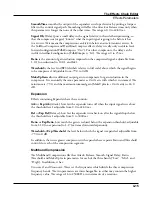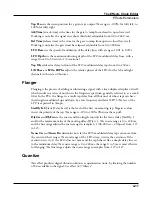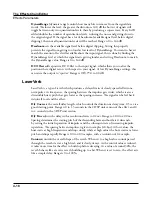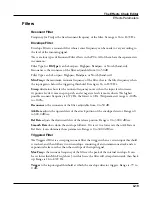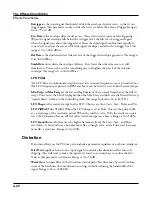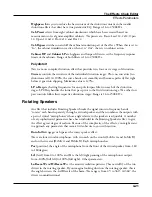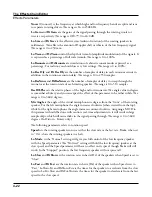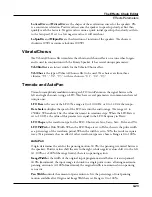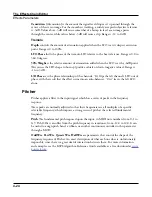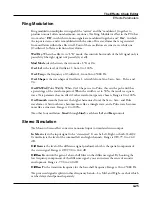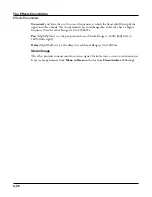
The Effects Chain Editor
Effects Parameters
4-11
Diff Scale
scales the “diffusion“ of the early reflections, that is, how spread out they are as a
group over time. At very low settings, the early reflections start to sound quite discrete, and
at higher settings the early reflections are seamless. It is adjustable from 0.00 to 2.00, with
1.00 being nominal for the given Room Type.
Density
controls how tightly the early reflections are packed in time. Low Density settings
group the early reflections close together, while higher values spread the reflections for a
smoother reverb. It is adjustable from 0.00 to 4.00, with 1.00 being nominal (and usually
optimal) for the given Room Type.
Expanse
controls the amount of late reverb energy biased toward the edges of the stereo
image. A setting of 0% will bias energy towards the center. Moving away from 0% will bias
energy towards the sides. Positive and negative values will have a different character.
Build
adjusts the envelope of certain portions of the reverb. Positive values speed up the
envelope, and negative values slow it down.
Size Scale
changes the size of the current room. Altering this parameter will change the
reverb time and also cause some coloration of the reverb. It is adjustable from 0.00 to 4.00,
with 1.00 being nominal (and usually optimal) for the given Room Type.
InfinDecay
, when turned “On”, causes the reverb tail to decay infinitely. When it’s “Off”,
the decay time is determined by the “Rvrb Time” or “LateRvbTim” parameters. This is a
good parameter to control with a footswitch.
Wet Bal
(Wet Balance). Some reverb effects are actually two stereo reverbs in one, with each
one receiving a different mono signal. This balances the outputs of the two reverbs—0%
means they are being mixed equally.
Delays
There are two types of taps in the Multitap delays: The “Loop” tap, which has a feedback
loop back to its input, and the numbered taps. The numbered taps can be single iterations or
they can repeat as part of a loop, but they do not have individual feedback paths.
Fdbk
(Feedback) Level controls the repeating function of the Loop Tap. A setting of 0%
means there will only be a single delay, while a setting of 100% means the signal keeps
repeating without ever stopping.
Both types of taps are individually adjustable from 0 to 2.55 seconds. The Loop Crs and
Tapn Crs (n being the number of the tap) parameters set the coarse value of the loop in 20-
ms increments, while the Loop Fine and Tapn Fine parameters set the fine value in 0.2-ms
increments.
In Delay effects that use tempo to determine tap lengths, there is a Tempo parameter which
can be set from 1 to 255 BPM or to “System,” which uses the global System Tempo. The
Loop Length and Tapn Delays are then expressed in beats relative to that overall Tempo.
Summary of Contents for Flash Play PC4
Page 1: ... It s the sound Part Number 910587 002 Rev B ...
Page 9: ... ix MIDI Implementation A 1 Specifications B 1 Index I 1 ...
Page 289: ... 8 40 ...
Page 328: ... 10 7 ...



















